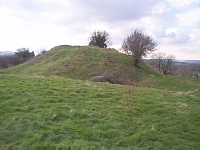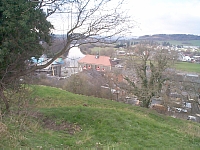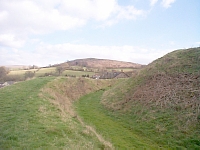Home | The Town | Castle Intro | Castle | Llywelyn | Links

Castell Buallt - Builth Castle
The Castle of Builth
As has already been mentioned,
there is some doubt as to whether the present castle site in the
middle of Builth was the first castle to be built in the cantref
of Builth. According to Remfrey, there seems evidence that the
first castle was at Caer Beris, overlooking the river Irfon, and
possibly built by Philip de Braose around 1095. However, in 1208
during the war against the Braose's family (Braose Wars
1208-11), Gerald Athee, Sheriff of Gloucester advanced up the Wye
and arrived at the Grange in Aberduhonw, just east of Builth,
where he stayed the night. The next day he set out for Builth to
build a castle but his forces were met by the troops of Rhys
Ieuanc and Owain (the sons of Gruffydd ap Rhys). The Welsh troops
forced Gerald Athee's men back into the Grange, they were
eventually forced to surrender and give hostages before being
allowed to retire (Gerald Athee had all the Broase Welsh lands
committed to him by King John). The relationship between the
marcher lords and the kings and princes of Wales over this period
would put any new television soap to shame with the marriages,
deceit, u-turns, murders and betrayals.
The castle is sited on the edge of an escarpment overlooking the
river Wye. The steepness of the scarp can be seen over the
stretch from the castle, along Broad Street to the Drovers Tea
Rooms. Climbing Ruth Lane (Cobble Lane) or the King's Head
Lane demonstrates how difficult climbing the scarp covered with
grass would have been to attacking forces. It is possible that
the early castle was only a motte, relying on the steepness of
the banks and basic walls for protection. In areas of unrest the
most important thing was to provide a protective base, not to
build a mansion, as can be seen in parts of the country where
peace reigned, but the symbol of authority was still needed.
There was probably a second scarp to the south of the castle
site, covering part of the present Oakands Crescent and Newry
Road, possibly cut away by the flow of the Gloew brook. This area
alongside the Gloew Brook has been altered as it was used as a
refuse landfill for the town for many years, as is evidenced by
the large amount of Victorian china and glassware that comes to
the surface, and can be seen on Newry Pitch just above the
Tanhouse.
The Lordship of Builth became Crown property in 1210 when
Englelard de Cigogne, Sheriff of Gloucester, led a joint
Anglo-Norman army along the Wye, and after suffering some 40
casualties, finished the project of building a castle at Builth.
(The fortification at Builth was at the King's command.) In
1217 Rhys Ieuanc and Owain ap Gruffydd rose against their uncle,
Reginald Mortimer, when he went back on a pact he had made with
Llywelyn. They won all of Builth, except the castle, which held
out until Llywelyn arrived in 1218, then Reginald surrendered
without resistance, after being repremanded he was allowed to
keep his lands.
In 1219 Henry III order the Sheriffs of Hereford, Gloucester and
Worcester to send workmen to help Reginald de Braose improve the
defenses of the castle, including digging ditches and clearing
woodland. Around 8th September, 1223, Llywelyn beseiged Reginald
in his castle at Builth, but the siege was broken when Henry III
and Justicular Earl Hubert Burgh of Kent left Hereford on 19th
September, by the next day, 20th, they were at Bronllys castle,
from where they advanced to Builth to break the siege.
Reginald died in 1228 to be succeeded by his son William, this
William was captured in October 1228 during Henry III's
disastrous Kerry campaign. On 12th February, 1229 William de
Braose was granted his freedom, but he had to pay Llywelyn
£2000, and also to grant him the Lordship and castle of
Builth as dowry for the marriage of his daughter Isabel to
Llywelyn's son and heir, Dafydd. On 2nd May 1230, Llywelyn ap
Iorwerth hung William de Braose when he was caught in a
compromising position with Joan, Llywelyn's wife. The Crown
appears to have opposed the transfer of Builth to Dafydd as the
agreed dowry, for its wardship was granted to William Marshall
Junior, the brother of Eva, William de Braose's widow.
Llywelyn, however, asserted Dafydd's claim for a letter of
September 1230 speaks of Gwyn ap Goronwy as Llywelyn's
Constable at the castle of Builth. Llywelyn's right to Builth
was eventually recognised by the treaty signed at Myddle in 1234.
The castle was destroyed by Llywelyn sooon after it was granted
to him in c.1230.
Llewelyn ap Iorwerth held Builth until his death on 11th April,
1240, Dafydd did homage to the King in May 1240, but his claim to
wider Lordships were already under dispute, rival claims were
brought against him by the Marcher lords and native Welsh over
Builth and other Lordships and repeated attemps at arbitration
failed. The castle site was again reclaimed for the Crown in the
summer of 1242 by John of Monmouth, who rebuilt the castle,
probably in stone, as building work progressed over several years
till 1247. At the treaty of Woodstock (1247) Builth became a
crown Lordship. In 1260 Llywelyn ap Gruffydd beseiged the castle,
once in January and again in July. It was this rebuilding and
re-inforcement that gave Builth castle the form we see today.
King Edward's man in charge of constructing his castles in
Wales was Master James of St. George who was paid 3/- a day for
his Welsh post (master of the King's Works in Wales) even
when he was absent. But building work at Builth was continued
under the supervision of Master Henry, one of Master James of St
George's assistants. In August 1282 the castle workforce was
put on a four-day-week "for lack of funds". A Master
Henry of Leominster and a Master William of Winchcombe are
recorded as master masons employed on the site in 1278. Iron and
steel would have been brought from Newcastle-under-Lyme. In 1278
the master mason earned 7-and-a-half pence a day, deputy master
3/- per week, four masons 2/- per week, five masons 1s 8d
per week, three masons 1s 6d, 34 hodmen and four water
carriers were each paid 7d per week, thirty diggers and twenty
barrow men 8d per week each, a carpenter was employed on
furnishings and fittings was paid 1s8d per week, while two
carpenters were making the stairs to the brattice over the gate
were each paid 3d per day, two smiths were employed to sharpen
the tools and make whatever metalwork was required. Two workmen
were employed to control the workmen. Altogether there were some
one hundred and forty on the pay roll in 1278, including
twenty-three women. It is believed that the workmen were housed
in temporary accommodation very close to the castle. Generally, a
seven day week was worked, but the accounts for 1278 show a three
day break at Whitsun and a two day break at All Saints.
Llywelyn was killed near Builth in 1282. (See Llywelyn page on this site)



left to right:
the motte and bailey; from the motte looking upstream of the Wye;
Part of the moat, north-west corner
In 1301, Edward I conferred Builth castle on his son Prince Edward (future Edward II). The charter of the gift of the Royal lands in Wales is dated 7th February, 1301. In 1327 Queen Isobella, wife of Edward II, handed Builth castle over to Roger Mortimer (Isobela and Roger Mortimer ruled in the name of the infant king, Edward III, from January 1327 to October 1330). Gilbert Talebot (Talbot) was Roger Mortimer's keeper at Builth in 1330, at a rent of £113-6-8d in moieties at easter and michaelmas.
Later, in 1330, the castle was granted to Eubelo L'Estrange and his wife Alice for life, Eubelo held the castle and Lordship until his death in 1335. His widow, Alice then married in c1336 Hugh de Frenes. The king then acknowledged him as Lord of Builth. Although the castle had been granted to Eubelo L'Estrange and his wife for life, the rights of the crown were re-asserted in 1343 when Edward III granted Builth Castle to his son Edward, the Black Prince. (Edward became Prince of Wales in 1343 and Builth was part of the lands granted to him).
The castle was not always occupied, William Rees quotes an example from 1343 on the resale, at a profit, of an annual tribute of cows which were not at the time needed to stock the larder.
In 1359 Builth castle was restored to the Mortimers in the name of Roger, who held it fee farm (Roger died in 1360). The value of the Lordship in 1398, when a Roger Mortimer died and the Mortimer estate was valued at £200. In November of 1401 the castle at Builth was put into a state of defence with Sir John Oldcastle as captain with 20 men-at-arms and 40 archers. The men were to serve three months, the men-at-arms were paid 12 pence a day each, archers ere paid 6d per day, each.
In 1420 when Builth was in the hands of Edmund Mortimer, the king made a grant of 100 marks a year to John Maybury out of the fee of £113-6-8d that Edmund paid to the crown for the castle and lordship of Builth. In November 1493 Henry VII granted to his son, Prince Arthur, the castle, town and lordship of Builth (Arthur died in 1502).
In 1525 the castle was in the hands of Thomas ap Owen. John Leland in his book "Itinery of Wales" (1536-39), states: "Builth apon wy is a good market town and ther is a fair castel of the kinges", but he also states elsewhere in the book, that Builth had formerly a strong castle, the site and earthen work of which still remain, but the building is destroyed. On May 7th, 1550, the lordship and manor of Builth, the castle, borough and the forest of Tal-y-fan, etc., were granted to Sir William Herbert, Knight of the Garter, the value of the lorhship was then said to be £447.
In Tudor times (1485-1603) Built castle was badly damaged by fire or fell into disuse and decay and the walls were dismantled and said to have been used to build many local houses.
Source references: Spurgeon "The Onfel Thomas Lectures"; Theophilus Jones "The history of Brecknock"; A Pictorial Guide to Builth Wells, M. Morrison; "Towns and Villages of Wales: Builth Wells" Sinclair and Fenn; The Castles of Wales Web site: "Builth Castle" (Lise Hull); "The Castles of Builth" (Paul Remfrey); William Rees: "South Wales and the March 1284-1415", 1924 edition.Apologies to any sources which have not been acknowledged. Thanks to A. Roberts for additional research for this article. © 2005
Home | The Town | Castle Intro | Castle | Llywelyn | Links
All photogaphs and other content copyright © 2005 P. Jones